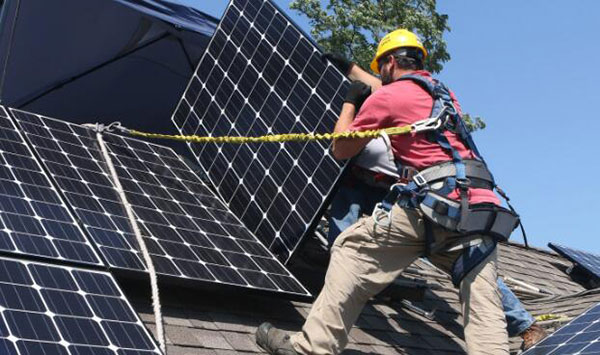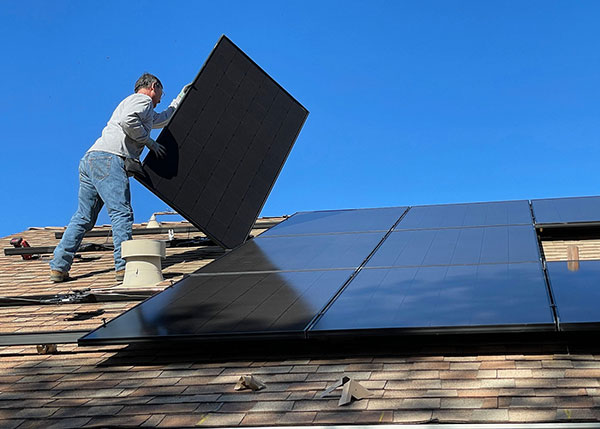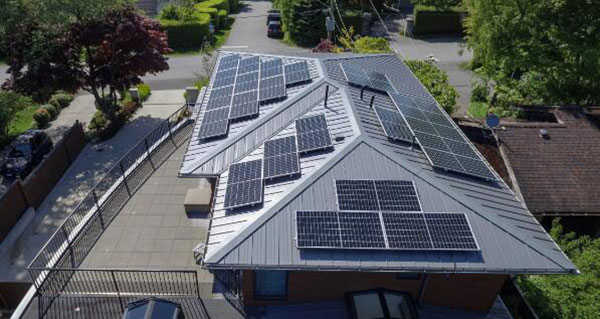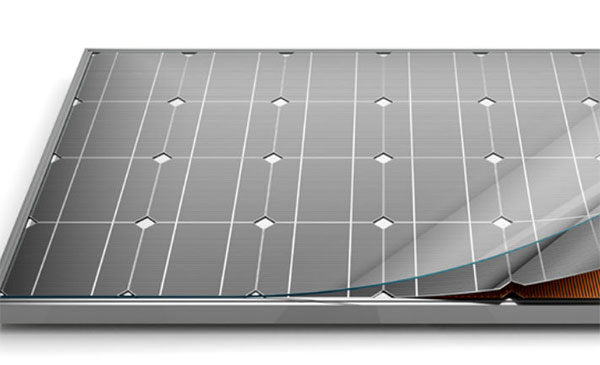Description
Solar panels can directly power your house, converting sunlight into electricity, but efficiency varies with weather and location.

Solar Panel Basics
Solar panel technology has revolutionized the way we harness solar energy, converting sunlight into electricity. Understanding the fundamentals of solar panels is essential for anyone considering their use for direct home power.
How Solar Panels Work
Solar panels consist of many smaller units called solar cells, usually made from silicon. These cells create an electric field that moves electrons when sunlight hits them, generating electricity. This process, known as the photovoltaic effect, is crucial in solar technology. The electricity produced is direct current (DC), which most home appliances cannot use directly. Therefore, an inverter is necessary to convert DC into alternating current (AC), the standard electrical form used in homes.
Types of Solar Panels
There are mainly three types of solar panels:
- Monocrystalline Solar Panels: Made from a single, continuous crystal structure, these panels are known for their high efficiency and sleek appearance. They often have a higher price but offer better performance in low-light conditions.
- Polycrystalline Solar Panels: Composed of multiple crystal fragments melted together, these panels are less efficient than monocrystalline panels but are also more affordable. They are easily recognizable by their blue, speckled appearance.
- Thin-Film Solar Panels: These panels use layers of photovoltaic material on a substrate. They are less efficient than crystalline solar panels but are lightweight and flexible, making them suitable for a variety of applications.
Efficiency of Solar Panels
The efficiency of a solar panel refers to its ability to convert sunlight into electricity. Typically, monocrystalline panels have efficiencies ranging from 15% to 20%, while polycrystalline panels range from 13% to 16%. Thin-film panels usually have lower efficiencies, around 10% to 13%. The efficiency of solar panels is a critical factor, as higher efficiency means more electricity generation per square meter, leading to a smaller footprint for the same power output. However, high-efficiency panels often come with increased costs, making it essential to balance efficiency with budget considerations.

Direct Powering vs. Energy Storage
Exploring the differences between direct powering and energy storage in solar panel systems is essential for optimizing solar energy use in residential settings. This comparison involves understanding how immediate energy use contrasts with storing solar energy for later use.
Immediate Energy Use
Immediate energy use, or direct powering, refers to using solar energy as it gets generated. During sunny hours, solar panels convert sunlight into electricity, which immediately powers home appliances. This method is highly efficient as it eliminates energy loss that might occur during storage. However, its major limitation is dependency on real-time sunlight. When sunlight is insufficient, like on cloudy days or during nighttime, the house must rely on other power sources, typically the grid.
Solar Energy Storage Systems
Solar energy storage systems involve storing excess solar power for future use, typically using batteries. These systems collect surplus energy generated during peak sunlight hours, making it available for use during periods without sunlight. Modern solar batteries, like lithium-ion, have high efficiency and longer lifespans, though they add significant cost to the solar setup. Proper sizing of the battery system is crucial; it must match the home's energy consumption patterns and the solar system's output to ensure optimal performance.
Grid-Tied Solar Systems
Grid-tied solar systems offer a balance between direct powering and energy storage. They allow homes to use solar power directly when available and draw from the grid when solar energy is insufficient. One significant advantage of grid-tied systems is the possibility of net metering. Net metering allows homeowners to send excess solar energy to the grid, often in exchange for credits on their electricity bills. This system not only provides a backup power source but also ensures efficient use of generated solar energy. However, grid-tied systems won't work during a power outage unless they include a battery backup.

Installation and Setup for Direct Power
Installing a solar panel system for direct power involves several critical steps, from understanding the necessary components to assessing your home's solar potential and executing the actual installation process.
Components Required for Direct Power
To set up a solar panel system for direct powering, you need:
- Solar Panels: The primary component that converts sunlight into electricity. The number and type of panels depend on your energy needs and roof space. The cost varies greatly based on the panel's type and efficiency, ranging from $0.70 to $1.50 per watt.
- Inverter: Converts DC from solar panels into AC for home use. The price and size of the inverter should match the system's total wattage.
- Racking System: Used to mount solar panels on the roof or ground. It must be durable and weather-resistant, adding to the overall installation cost.
- Wiring and Electrical Components: Includes all necessary wiring, connectors, and a junction box for safe electrical connections.
- Performance Monitoring System: To track the efficiency and output of your solar panels.
Assessing Your Home's Solar Potential
Before installation, assess your home's solar potential, which involves:
- Roof Analysis: Check the condition, size, angle, and orientation of your roof. South-facing roofs in the Northern Hemisphere get the most sunlight.
- Shade Analysis: Buildings, trees, and other structures can cast shadows, reducing solar panel efficiency.
- Local Climate: Areas with more sunny days per year will generate more solar power.
- Energy Needs: Calculate your average energy consumption to determine the size of the solar system needed.
Installation Process
The solar panel installation process typically involves:
- Site Inspection and Permits: A professional installer inspects your site and obtains necessary permits.
- Designing the System: Based on your home's architecture and energy needs, a system design is created.
- Installation: Professional installers set up the racking system, install panels, inverter, and make all electrical connections.
- Connection to the Grid: If your system is grid-tied, it needs connection to the local utility grid, which may require an inspection.
- Testing and Commissioning: After installation, the system is tested to ensure it operates correctly.

Managing Energy Consumption
Managing energy consumption is crucial for households utilizing solar power. It involves monitoring energy usage, balancing between solar power and grid electricity, and adopting energy-saving practices specifically tailored for solar-powered homes.
Monitoring Energy Usage
Monitoring energy usage is key to maximizing the efficiency of a solar power system. Homeowners can use smart energy monitors that provide real-time data on energy consumption and solar power generation. These systems can track usage patterns, identify energy-intensive appliances, and suggest ways to reduce consumption. Some advanced systems even offer predictive analysis based on historical data, helping to optimize energy use. Typically, these monitoring systems can cost from $200 to $500, depending on their complexity and features.
Balancing Solar Power and Grid Electricity
Balancing solar power with grid electricity is vital for homes not entirely off-grid. During peak sunlight hours, solar panels might generate more power than the home can use. With net metering, this excess power can offset electricity taken from the grid during low sunlight periods. However, if net metering is not available, homeowners might consider solar batteries, although this increases the overall system cost. The cost of a solar battery system can range from $5,000 to $7,000, but it significantly enhances energy independence.
Energy-Saving Practices for Solar-Powered Homes
Adopting energy-saving practices can further enhance the efficiency of solar-powered homes. These practices include:
- Using Energy-Efficient Appliances: Replacing old appliances with energy-efficient models can significantly reduce power consumption.
- Optimizing Usage Time: Running power-intensive appliances during peak solar hours maximizes the use of solar energy.
- Smart Home Automation: Installing smart thermostats, LED lighting, and automated systems can help in reducing unnecessary energy use.
- Regular Maintenance: Keeping solar panels clean and ensuring they are in good condition can improve their efficiency and lifespan.

Challenges and Considerations
When transitioning to solar power, several challenges and considerations come into play. These include understanding how weather and seasonal changes affect solar power, maintaining and ensuring the longevity of solar panels, and conducting a thorough cost-benefit analysis.
Weather and Seasonal Impacts
Solar power systems face varying efficiency levels depending on weather conditions and seasons. For instance, solar panels produce less electricity on cloudy or rainy days. In winter, shorter daylight hours result in reduced solar energy production. Regions with frequent heavy snowfall also face challenges, as snow cover can block sunlight from reaching the panels. To mitigate these issues, homeowners may need to invest in systems with higher wattage or efficiency ratings. Solar panels typically range from 250 to 400 watts, with higher wattage panels performing better in less-than-ideal conditions but also costing more.
Maintenance and Longevity of Solar Panels
Maintaining solar panels is relatively straightforward, but it's crucial for their efficiency and longevity. Panels generally require cleaning a few times a year to remove dust, leaves, or snow. Furthermore, ensuring that the wiring and inverters are functioning correctly is important. While solar panels are durable, with many manufacturers offering 25 to 30-year warranties, inverters may need replacement every 10 to 15 years, adding to long-term maintenance costs. Regular maintenance checks, which can cost a few hundred dollars annually, help in identifying and fixing issues early, thereby extending the system’s lifespan.
Cost-Benefit Analysis
Conducting a cost-benefit analysis is essential when considering a solar power system. The initial investment includes the cost of solar panels, inverters, batteries (if needed), installation, and any structural modifications to the property. These costs can range from $15,000 to $30,000 for an average-sized residential system. However, the long-term benefits often outweigh these initial expenses. These benefits include reduced electricity bills, tax incentives, and increased property value. Additionally, solar power systems contribute to a lower carbon footprint. Homeowners should also consider factors like their location's solar potential and electricity rates to accurately gauge the return on investment.








